Grilling Using Extra Virgin Olive Oil: Should You Oil Chicken Before Grilling?
For all the grill masters out there, knowing how to perfectly prepare and cook your meats is a necessary part of the craft. While traditional grilling methods use heavier cooking substances like vegetable oil, swapping these items out for extra virgin olive oil can give your grilled goods a healthy twist.
Grilling with extra virgin olive oil not only imbues your food with extra flavor but also provides a slew of health benefits. When it comes to oiling meats, you can achieve a perfectly seared result with a hearty coating of extra virgin olive oil, all while retaining the meat’s natural and juicy flavors.
In this article, we will cover everything you need to know about grilling with extra virgin olive oil – from whether you should oil your chicken and other meats before grilling to how to properly prepare your grill. Keep reading to learn even more awesome ideas for how to use extra virgin olive oil with your grill!
Table of Contents
The Basics of Grilling Using Extra Virgin Olive Oil
Does Olive Oil Have a High Enough Smoke Point for Grilling?
How to Apply Olive Oil for Grilling
Preparing Your Grill for Cooking with Olive Oil
Why Using Extra Virgin Olive Oil for Grilling is Beneficial
Grilling Chicken with Extra Virgin Olive Oil
Preparing the Chicken Before Grilling
Different Methods for Applying Extra Virgin Olive Oil to Chicken
The Basics of Grilling Using Extra Virgin Olive Oil
Extra virgin olive oil has many uses in cooking – but many people miss out on using it as a key ingredient in their grilled recipes due to the misconception that it is not compatible with grilling.
In truth, extra virgin olive oil is a very versatile and high-quality substance that can be used in almost every cooking method. The key is to understand how to identify which olive oils are best for grilling, how to properly apply olive oil before grilling, and how to correctly prepare your grill with olive oil.
This section will cover all of these grilling with olive oil basics and more!
Does Olive Oil Have a High Enough Smoke Point for Grilling?
A major point of misconception when it comes to olive oil is its smoking point.
Grillers who use vegetable or other cooking oils when grilling often do not realize extra virgin olive can be used on their grills. It is, unfortunately, widely perceived that olive oil does not have a high enough smoking point compared to other oils.
An oil’s smoke point is the temperature at which the oil will begin to burn, resulting in the production of smoke. Once an oil reaches its smoke point, the likelihood of overcooking and burning foods becomes much more prevalent. Thus, oils with higher smoke points are often used for grilling as they can withstand higher temperatures without starting to burn.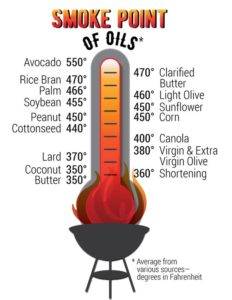
When grilling foods, a grill will typically be heated to between 400 to 500 degrees Fahrenheit. As a result, the oils used need to have a high smoke point to withstand this heat for longer. The recommended smoke point for a grilling oil is generally between 350 to 450 degrees Fahrenheit, with smoke points above 400 degrees preferred.
This is where the misconception regarding olive oil’s smoke point comes in. Olive oil is often equated to other light cooking oils, such as coconut oil, which have fairly low smoke points. Yet, according to Healthline, the average bottle of olive oil has a smoke point between 374 to 405 degrees Fahrenheit – well within the range needed for grilling.
Additionally, extra virgin olive oil can vary pretty drastically in how much heat it can withstand depending on its refinery processing. Thus, more refined and high-quality olive oils are likely to have an even higher smoke point, making them an ideal choice for grilling.
How to Apply Olive Oil for Grilling
With the question of olive oil’s smoke point out of the way, let’s move on to how the best ways to apply olive oil when grilling.
Due to the slightly lower smoking point of olive oil, it is best to apply olive oil directly to the foods you are cooking, rather than to the grill itself. However, you can also use olive oil to prepare and season your grill beforehand, which we will discuss more in the next section.
 Adding olive oil onto the foods you are cooking before grilling is beneficial for many reasons. Not only will you give the oil more time to heat up and cook the food thoroughly but you will also reduce the risk of food and debris sticking to the grill itself.
Adding olive oil onto the foods you are cooking before grilling is beneficial for many reasons. Not only will you give the oil more time to heat up and cook the food thoroughly but you will also reduce the risk of food and debris sticking to the grill itself.
This method also helps you control the amount of olive oil used for cooking and flavoring your meats, veggies, and other foods. For instance, for a richer and more robust flavor, you could marinate your ingredients in olive oil and spices of your choosing for a few hours before firing up the grill.
Preparing Your Grill for Cooking with Olive Oil
While you may not want to apply olive oil directly to your grill right before adding your ingredients, you can use it to prepare and season your grill beforehand.
Seasoning is a protective process using heated oil that is typically used on cast iron pans. However, the seasoning process can also be highly beneficial for your grill as well. By coating the grates of your grill in a thin layer of oil and then allowing this oil to heat and smoke, your grates are protected against rusting and are easier to clean after use.
During the seasoning process, you will want to bring whichever oil you use to its smoking point. As mentioned earlier, some olive oils will have a higher smoke point than others. Specifically, California extra virgin olive oils are known for their high quality and are often recommended for this seasoning process.
To begin seasoning your grill with olive oil, proceed with the following steps:
- For new grills, you can apply the oil right away. However, for older grills that have debris on the grates, you should try to scrape as much off as possible, as well as wipe down the grills with dish soap and warm water. This will help the oil to do its job once it is applied and heated.
- Cover the entirety of the grill grates with olive oil. You want this coating to be a thin layer, not thick or dripping. If you do go too heavy-handed in the application, simply go back over it with a towel to remove any excess oil.
- Crank your grill up to high and allow the oil to begin smoking. You want the olive oil to completely burn away, which can take anywhere from 15 to 30 minutes. A good rule of thumb for gauging how much of the oil has burned away is to keep an eye on the color of the grates – the darker and more matte they look, the more the oil has burned off.
- Once the oil is completely smoked and gone, the grill is ready for use! After use, make sure to clean up any debris for easy preparation next time.
For the best results from your grill, season it between each use.
Why Using Extra Virgin Olive Oil for Grilling is Beneficial
Grilling foods is already a healthier alternative to frying. This is due largely to the fact that the high and direct heat of the grill helps to release more fat from foods, resulting in an overall lower calorie result.
When you use extra virgin olive oil in your grilling recipes, you can take this health boost to the next level. Extra virgin olive oil comes with a slew of natural health benefits, especially if it has been cold-pressed. Cold pressing is a method of processing and refining olive oil without heat, allowing the substance to retain more of its natural flavor and nutrients.
Here are 5 key health benefits of using extra virgin olive oil when cooking:
-
Healthy Fats
Olive oil is made up primarily of a monosaturated fat known as oleic acid. This kind of fat has many benefits compared to heavier cooking oils, including helping to lower cholesterol and enabling easier maintenance of a healthy weight.
-
Abundant Nutrients
Olive oil naturally contains many essential vitamins and nutrients. These include vitamin E, vitamin K, and a variety of antioxidants that have highly beneficial biological effects. The vitamins found in olive oil can help support immune function and improve skin and bone health, while the antioxidants are fantastic for helping to prevent health conditions like stroke or disease.
-
Anti-Inflammatory Properties
The combination of oleic acid and other antioxidants in olive oil makes for a powerful anti-inflammatory mixture. This is especially important for individuals who are at risk of serious disease, as chronic inflammation can be a major driver behind the progression of diseases like cancer, heart disease, and type 2 diabetes.
-
Improved Blood Flow
Along with lowering inflammation levels, the nutrients found in olive oil can also help to protect the body against bad cholesterol. As a result, this can improve a person’s blood vessel linings, as well as prevent excessive blood clotting.
-
Anti-Bacterial Properties
Harmful bacteria that come from contaminated foods or other sources can cause serious stomach issues, such as ulcers or even cancer in some cases. The nutrients found in olive oil have been proven to fight multiple strains of bacterium that can result in serious health conditions if left untreated.
Grilling Chicken with Extra Virgin Olive Oil
One of the best foods you can grill using extra virgin olive oil is chicken.
Why? Well, chicken cooks at a faster rate than darker meats, making it the ideal companion for oils with a lower smoke point. Additionally, the light flavor of chicken combines well with the earthy and more decadent notes of extra virgin olive oil.
Besides adding an extra dose of flavor, extra virgin olive oil can also help to lock in the juiciness of the chicken as well. Olive oil helps to brown the outside of the chicken, bringing it to a beautiful golden color, while still maintaining the meat’s internal moistness. This is especially important when grilling, as chicken can quickly become dried out when cooked directly over the grill’s heat.
There are many different ways to use olive oil on your grilled chicken, many of which we will cover in this section. With this in mind, let’s discuss how to prepare the chicken before grilling, the different methods for applying olive oil, and how long to grill your chicken for!
Preparing the Chicken Before Grilling
The very first thing you should do to your cuts of chicken before grilling is to get your workstation set up with all the olive oil, spices, and other supplies you need. While it may seem like a simple step, having a well-organized workstation will help you not only with preparation but later on during cleanup as well.
We will cover the different methods for applying olive oil in greater detail in a moment, but for now, let’s discuss spices. Chicken coated in olive oil is very versatile, with the layer of olive oil allowing a variety of additional ingredients to give the exterior of the meat a phenomenal flavor.
Luckily, extra virgin olive oil is highly versatile as well and can be paired with a full range of different flavors and spice mixtures.
For a lighter flavor, consider mixing your olive oil with fresh herbs and a squeeze of lemon. As for more robust and heavier flavors, you can use seasonings such as smoked paprika or cajun powder to give your chicken a heartier bite.
Keep in mind that the final flavor will be highly dependent on the way you choose to apply the olive oil to the chicken. This takes us to our next topic – the many methods for applying olive oil.
Different Methods for Applying Extra Virgin Olive Oil to Chicken
While some grill masters will choose to simply dunk their chicken in olive oil and then throw it right on the grill, there are actually many different application methods to choose between.
The way you apply extra virgin olive oil to chicken beforehand will have a tremendous impact on the final flavor. For example, a light coating of oil will help bring out more of the chicken’s natural flavors, while heavier coatings will give the chicken a deeper and more infused flavor.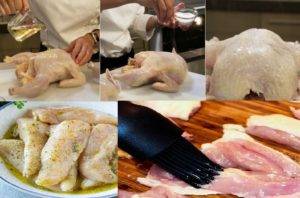
Here are 4 excellent methods for applying extra virgin olive oil to chicken:
-
Brushing
Brushing on olive oil is by far the simplest and easiest method for applying the substance. Simply fill a shallow dish with the oil, add any fresh herbs or juices, and use a silicone or bristle brush to dust on the oil mixture to all sides of the chicken. This will result in a very light coating of oil, perfect for a breezy summer afternoon.
-
Rubbing
Rubbing chicken is a method of applying oil and seasonings directly to the chicken with your hands. Start with a light coat of olive oil (adding too much will allow the seasonings to drip off on the grill) and then graciously season both sides with your selected spice blend. Then, rub those spices in with your hands, ensuring they are well-attached to the exterior of the chicken.
-
Basting
Basting is a slightly more complex method for applying olive oil – but it can yield phenomenal results. Start with a very light coating of olive oil on the chicken to keep it from sticking to the grill. Once it has started cooking, apply your basting mixture with a silicone brush or baster. Flip the chicken and allow it to cook a bit longer before basting the other side. This results in a delightfully crispy and flavorful exterior, perfect for chicken wings and drums.
-
Marinating
The most intensive of these four methods is the marinade. Marinating is not overly complex but rather requires a good bit of patience. First, you must create your marinade using olive oil as your base ingredient. Once the marinade is prepared, your chicken pieces should be added into a large bowl or bag, fully submerging them in the marinade. From here, it’s time to wait – generally, at least 5 to 6 hours, though non-acidic marinades can be left overnight for extra flavor. Once the marination is complete, simply throw that tasty chicken on the grill!
How Long to Grill Chicken For
The length of time you need to cook your chicken will vary according to what cuts you are using.
For example, chicken tenderloins will grill a lot faster than breasts. You can also grill an entire bird if you so desire, which will take the longest period of time.
Here is a quick breakdown of the average times and internal temperatures to strive for according to your meat cuts:
-
Wings
You want your wings to be crispy on the outside and juicy on the inside, so we recommend between 20 to 25 minutes or an internal temperature between 165 to 175 degrees Fahrenheit. Despite being smaller in size, chicken wings can be left to grill for just as long as tenderloins or even breasts. This is partially in thanks to the skin remaining intact, allowing the chicken to withstand higher heat levels for longer. Make sure to flip these regularly!
-
Tenderloins
Chicken tenderloins are one of the smallest cuts of the meat you can get, making their cook time extraordinarily fast. We recommend between 8 to 12 minutes total or until they reach an internal temperature of 165 degrees Fahrenheit. Flip your tenderloins at about the 4 to 5-minute mark to ensure both sides are crisp and golden.
-
Breasts
Chicken breasts can vary in size in thickness, making them a bit harder to set a definitive time for. In this case, it is better to pay attention to the internal temperature and outer appearance. We recommend between 15 to 25 minutes for chicken breasts, or until they reach the internal temperature of 165 to 175 degrees Fahrenheit. Like with the tenderloins, flip these at about the halfway mark to get both sides golden and grilled to perfection.
-
Whole Bird
If your grill is large enough, you can even use it to cook an entire bird. When cooking a whole bird, you will need to leave it in a covered grill with the thickest parts facing the hottest side of the grill for between 40 minutes to an hour. Checking internal temperatures is especially important here. Other parts of the bird will heat faster, but you must wait until the thickest part of the bird reaches 165 degrees Fahrenheit before serving.
-
Butterflied Bird
A butterflied bird is a whole chicken that has had its backbone removed and its breast bone broken so it can be flattened. This method allows a whole chicken to be grilled faster – typically between 30 to 45 minutes. Like with the whole bird, you will need to wait until the thickest part of the bird reaches an internal temperature of 165 degrees Fahrenheit.
Four Great Foods to Grill with Extra Virgin Olive Oil
Now that we have covered everything you need to know about grilling chicken with extra virgin olive oil, let’s discuss some additional foods and recipes that go great on the grill.
Once you start grilling your foods with olive oil, it’s hard to go back to your old ways. This is largely due to olive oil’s ability to hold in moisture while also imbuing your meats, veggies, and other foods with immense flavor – not to mention the health benefits of olive oil we discussed earlier!
Below, we have included 4 examples of awesome foods to try on the grill, as well as our own Secolari original recipes to try out. Add one, a few, or all of these recipes to your cookbook to give your grill season some new flair and flavor!
1. Sausages
Nothing beats a perfectly grilled sausage, dripping in delicious juices and flavored oils.
To grill sausages, you will generally need to leave them on the grill for between 10 to 15 minutes, flipping regularly to avoid one side becoming burnt. Sausages are especially delicious when grilled with an olive oil-based beer or wine marinade or basting mixture.
For a delicious grilled sausage, try out our Sausage al Vino Rosso recipe. Originally created with pan-frying in mind, this recipe can be easily altered by using the olive oil and wine found in the recipe as a marinade or basting mixture.
This recipe goes great with fresh herbs like rosemary and chopped garlic. Toast up some buns to make this sausage recipe into the perfect grilled sandwich.
2. Portobello Mushrooms
Portobello mushrooms make great grilling foods thanks to their naturally rich decadence.
The natural flavors of these mushrooms can be greatly enhanced by olive oil-based marinades that include more acidic ingredients, such as balsamic vinegar. By grilling Portobellos, you can lock in the delicious flavors while also achieving a beautifully golden and charred exterior.
To try out grilled Portobellos, follow our recipe for Balsamic Marinated Portabella Mushrooms. This recipe combines Californian and Mediterranean flavors to create an unforgettable dish.
Eat these mushrooms on their own or use them as toppings for salads and sandwiches – the possibilities are endless!
3. Fish
Like chicken, fish and olive oil make a great light pairing for your next grilling session.
Fish contain many natural flavors and juices that olive oil can help to enhance and lock in once grilled. The charred flavors that come from grilling with olive oil make the need for excessive spices or sauces unnecessary – just add a bit of fresh herbs, salt, pepper, and balsamic!
At Secolari, we have many awesome fish recipes to choose from. Get a taste of many different types of grilled fish with our Grilled Fish Spiedini recipe, which combines the flavors of salmon, swordfish, and wild-caught shrimp to create the ideal appetizer or entrée!
4. Shish Kabobs
Sear your meats and veggies together to perfection by making a hearty batch of grilled shish kabobs!
A shish kabob is a traditional Arabic dish – “shish” means skewer in Arabic, after all. This type of dish is an all-in-one type of recipe, giving you delicious bites of all your favorite meats and vegetables all on one singular skewer.
For this item, try our Chicken Shish Kabob recipe. This recipe combines tender chicken with bell pepper, red onion, cherry tomatoes, and decadent Portobello mushrooms – doused in olive oil and balsamic vinegar – to create the ideal dinner-time skewer.
Plus, these shish kabobs make for great leftovers – if you can manage to not eat them all at once, of course!
Additional Cooking Uses for Extra Virgin Olive Oil
By now, you have learned all of the amazing uses and benefits of olive oil when grilling – but there’s much more to be achieved with this delightful substance.
If olive oil was not a staple in your kitchen before, it certainly will be now! Below, we have detailed 4 additional cooking uses for extra virgin olive oil:
1. Using Extra Virgin Olive Oil with Cast Irons
Cast iron pans are great alternatives for achieving similarly beautiful searings and chars when you do not have a grill available. These oven-safe pans are highly versatile and can create a number of diverse dishes – from steaks to cookie skillets!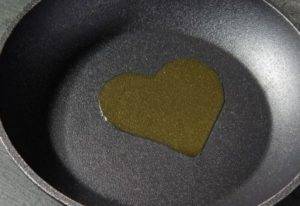
Like with the grill, cast irons need to be seasoned between each use – a job that is perfect for your highest quality olive oil. Unlike seasoning a grill – which has its own heat source – you will need to season a cast iron using a home oven. This will result in some smokiness in your home, so make sure to have a window open and your overhead oven ventilation fans running.
2. Baking with Extra Virgin Olive Oil
Extra virgin olive oil is considered oven safe for any dishes cooked under 450 degrees Fahrenheit – including many baking recipes.
For instance, the next time you make a batch of scrumptious brownies, consider swapping out the vegetable oil for olive oil. By doing so, not only will your brownies be mildly healthier, but they will also have an extra dose of flavor and richness.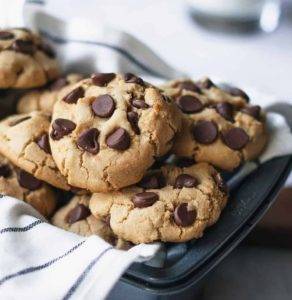
When replacing vegetable or other cooking oils with olive oil in baking recipes, you can generally follow a 1 to 1 ratio. For example, if the recipe calls for one cup of vegetable oil, simply swap this out for one cup of olive oil instead!
3. Replacing Butter with Extra Virgin Olive Oil
It’s hard not to love butter – especially when it has so many versatile uses.
However, you can replace butter with extra virgin olive oil for a superior flavor and added health benefits in most recipes. Even just butter on toast can be replaced with a drizzle of olive oil to achieve that same rich taste sensation!
By finding ways to replace butter with olive oil, you can make recipes that are otherwise unhealthy into more health-conscious meals and snacks without having to sacrifice flavor.
4. Creating Dressings and Sauces with Extra Virgin Olive Oil
Extra virgin olive oil makes the perfect base for many salad dressings and sauces, allowing you to cut back on calories without doing away with your favorite liquid toppings.
For salad dressings, there are an abundance of different ways to use olive oil to create your own homemade mixture. You can even use olive oil on its own as a dressing, as it is perfectly flavorful enough on its own.
As for sauces, olive oil can make the perfect base for sauteeing veggies and reducing sauces in a pan. For example, a simple tomato pasta sauce can be elevated with the use of olive oil to bring out the earthy flavors, as well as give the sauce a more rich and luscious texture.
Final Thoughts
Well, there you have it – you now know everything you need to know about grilling with extra virgin olive oil.
From creating a beautifully golden and crisp chicken recipe to using extra virgin olive oil as a marinade base for all foods, there are so many different uses for the substance when grilling. Not to mention the abundance of health benefits that come with the oil!
When you are ready to get your kitchen stocked with gourmet extra virgin olive oils that are grown and produced within California, then explore Secolari’s collection of premier olive oils today! Along with traditionally flavored options, we also offer a variety of seasonal and flavored olive oils to give you a wide array of different taste sensations.
If you found this article helpful, make sure to check out the rest of our blog and our extensive collection of original recipes – all using extra virgin olive oil.
Now – get to grilling!

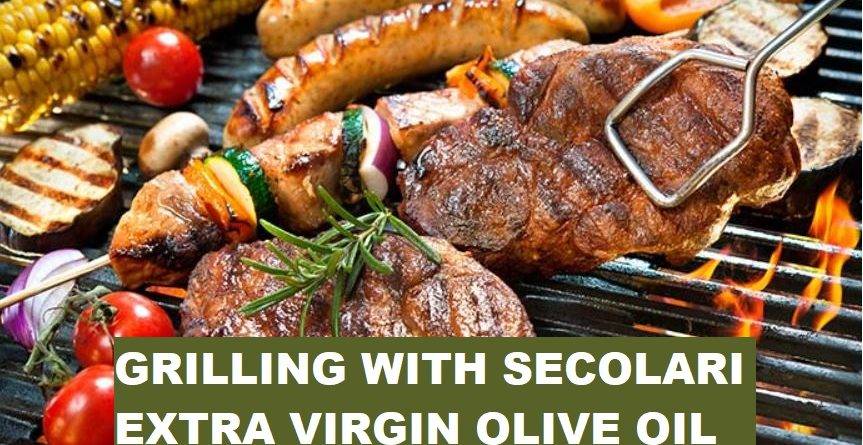
Comments (2)
[…] For all the grill masters out there, knowing how to perfectly prepare and cook your meats is a necessary part of the craft. While traditional grilling methods use heavier cooking substances like vegetable oil, swapping these items out for extra virgin olive oil can give your grilled goods a healthy twist. Grilling with extra virgin … […]
[…] I mentioned earlier, it’s equally essential to oil both the chicken and the grill. What oil you choose also has an impact on your […]